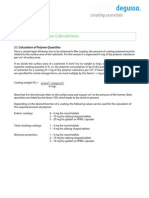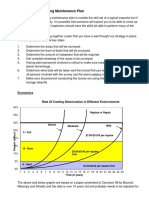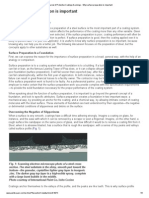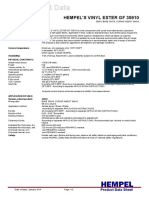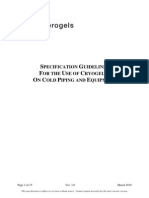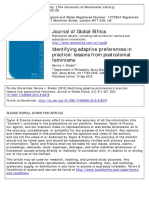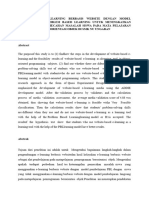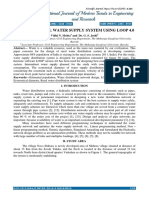Spreading Rate PDF
Spreading Rate PDF
Uploaded by
Esapermana RiyanCopyright:
Available Formats
Spreading Rate PDF
Spreading Rate PDF
Uploaded by
Esapermana RiyanOriginal Title
Copyright
Available Formats
Share this document
Did you find this document useful?
Is this content inappropriate?
Copyright:
Available Formats
Spreading Rate PDF
Spreading Rate PDF
Uploaded by
Esapermana RiyanCopyright:
Available Formats
SPREADING RATE / COVERAGE
General Information
Theoretical Spreading Rate / Coverage
The Theoretical spreading rate or coverage of a coating is a function of the volume solids. The volume solids is the
percentage of the coating consisting of binder and pigments which remain on the substrate, forming the final paint film
after the volatile components or solvents evaporate.
In the U.S. measurements, one U.S. gallon of paint with 100% solids by volume will cover 1,604 square feet of surface
area at a dry film thickness of 1 mil. The theoretical coverage of any coating can be calculated from the following
formula, knowing the solids by volume (SBV) and the desired dry film thickness (DFT):
1604 x SBV = Theoretical Coverage
DFT (mils)
Example:
65% solids by volume coating applied at 5.0 mils dry film thickness
1604 x (0.65) = 208.52 square feet per gallon
5
In metric measurement, one liter of paint with 100% solids by volume will cover 1,000 square meters of surface area at
a dry film thickness of 1 micron. To calculate the theoretical coverage of a coating in metric units, utilize the following
formula:
100 x SBV = Theoretical Coverage
DFT (microns)
Example:
65% solids by volume coating applied at 125 microns dry film thickness
1000 x (0.65) = 5.2 square meters per liter
125
Practical Spreading Rate / Coverage
The theoretical formulas above assume that all the coatings (except solvents) are uniformly applied to the substrate
with no over spray or application loss. The theoretical coverage is used in calculating cost comparisons between
coatings systems and suppliers and establishes a factual starting point from which the practical spreading rate/coverage
can be estimated. The practical coverage makes allowances for application losses and is a more reliable indicator of
what will be experienced in the field. Application losses are affected by many factors, including wind, application
technique, application equipment, and type/profile of the substrate to be coated. Loss factors vary depending on the
specific situation.
The practical coverage/spreading rate of a coating are calculated as follows:
Theoretical coverage x (1-loss factor) = Practical Coverage
Example:
Theoretical coverage of 200 square feet per gallon at recommended dry film thickness
Loss factor of 30%
200 sq. ft./gal x (1-0.30) = 140 square feet / gallon
Paint Consumption
In order to estimate the total number of gallons necessary for a specific job, it is necessary to know the total area to be
painted. Theoretical and/or practical paint consumption estimates can then be calculated using the following formulas:
Total Area (ft2 or m2) =Theoretical Consumption (Gal or L)
Theoretical Coverage (ft./gal2 or m/l2)
Or
Total Area (ft2 or m2) =Practical Consumption (Gal or L)
Practical Coverage (ft./gal2 or m/l2)
POWERWRAP LP
www.powerwraplp.com 3605 W Pioneer Pkwy, Suite C, Arlington TX 76013 USA (817) 303-7473 2011 PowerWrap LP
You might also like
- JOTUN Survey ReportDocument2 pagesJOTUN Survey ReportMosstafa Faisal100% (2)
- 2.2e Coating Formulation CalculationDocument6 pages2.2e Coating Formulation CalculationNitesh Shah100% (2)
- AISC Steel Construction Manual, 13th Edition, Second PrintingDocument8 pagesAISC Steel Construction Manual, 13th Edition, Second PrintingLuis Gonzales Salazar67% (3)
- TSR and Application LossesDocument4 pagesTSR and Application LossesFreddy Carl Fredricksen100% (1)
- Paint Calculation FormulaDocument1 pagePaint Calculation FormulaOmer aliNo ratings yet
- Anchor-Profile SSPC SPDocument9 pagesAnchor-Profile SSPC SPandy100% (1)
- Rectangular TankDocument6 pagesRectangular TankEsapermana RiyanNo ratings yet
- GAP GuidelinesDocument29 pagesGAP GuidelinesEsapermana Riyan100% (1)
- Pipe Stress Manual CalcDocument62 pagesPipe Stress Manual CalcEsapermana Riyan100% (2)
- Trunnion Calculation SheetDocument3 pagesTrunnion Calculation Sheetsudhisnair67% (3)
- Theoretical and Practical CoverageDocument4 pagesTheoretical and Practical CoverageSherif AbdelhameedNo ratings yet
- Coverage Spreading Rate and Paint Consumption Calculations 01nov2022Document4 pagesCoverage Spreading Rate and Paint Consumption Calculations 01nov2022Tirumala PrasadNo ratings yet
- Paint Calculation: Factor To Consider AreDocument1 pagePaint Calculation: Factor To Consider AreKalyanasundaram ThirugnanasambandamNo ratings yet
- 7 CalculationDocument15 pages7 CalculationMohamed NouzerNo ratings yet
- Tips Calculation-JotunDocument17 pagesTips Calculation-JotunRodrigoMorenoNo ratings yet
- Sae Spec For Steel Shot & GritDocument3 pagesSae Spec For Steel Shot & Gritsanoopvk100% (1)
- Jotun Paint TrainingDocument75 pagesJotun Paint TrainingZvonimir OzanNo ratings yet
- VS Calculations %vs DFT X 100 WFT: Page 1 of 1Document1 pageVS Calculations %vs DFT X 100 WFT: Page 1 of 1Bayu FalenNo ratings yet
- Paint Volume SolidsDocument7 pagesPaint Volume SolidsjasminneeNo ratings yet
- Project To Estimate The New Shot Blasting & Painting Facility For New ProjectDocument24 pagesProject To Estimate The New Shot Blasting & Painting Facility For New ProjectHarshad_SNo ratings yet
- Paint Technology Diploma Course AssignmentDocument11 pagesPaint Technology Diploma Course AssignmentAnonymous UdYX3b100% (1)
- BGas Excercise Page 2Document1 pageBGas Excercise Page 2Bayu FalenNo ratings yet
- Paint CalculationDocument3 pagesPaint CalculationJahidul IslamNo ratings yet
- Boat Laning CoatingDocument1 pageBoat Laning Coatingwaleedyehia100% (1)
- Consumption Calc CarbolineDocument10 pagesConsumption Calc CarbolineImam Situmeang100% (1)
- Calculating Paint Consuption Lib (Compatibility Mode)Document17 pagesCalculating Paint Consuption Lib (Compatibility Mode)riky nurgiantoro100% (1)
- TSS - Overcoating Document - TSS-X CUT+TI-069-01+Overcoating+an+unknown+coatingDocument5 pagesTSS - Overcoating Document - TSS-X CUT+TI-069-01+Overcoating+an+unknown+coatingRifki Fathurrahman100% (1)
- Interthane 990 Test Data PDFDocument2 pagesInterthane 990 Test Data PDFImam Situmeang100% (2)
- Establishing A Coating Maintenance Plan PDFDocument11 pagesEstablishing A Coating Maintenance Plan PDFRicardo MendesNo ratings yet
- Shin CombinedDocument29 pagesShin CombinedAce Ace100% (1)
- Challenging The Organic "Zinc Rich" Primer StandardDocument9 pagesChallenging The Organic "Zinc Rich" Primer Standardaliabdulhamid100% (2)
- Dr. Bugs Tan ADIPEC Conference PaperDocument23 pagesDr. Bugs Tan ADIPEC Conference PaperDr Bugs Tan100% (1)
- Bgas 3.2 Maths Exercise WFT Calculations WFT 100 X DFT VS: Page 1 of 1Document1 pageBgas 3.2 Maths Exercise WFT Calculations WFT 100 X DFT VS: Page 1 of 1Bayu Falen100% (1)
- The Journal of Protective Coatings & Linings - Why Surface Preparation Is ImportantDocument5 pagesThe Journal of Protective Coatings & Linings - Why Surface Preparation Is ImportantSergio Daniel Barea Nuñez100% (1)
- Hempel'S Vinyl Ester GF 35910: Description: Recommended UseDocument2 pagesHempel'S Vinyl Ester GF 35910: Description: Recommended UseEngTamerNo ratings yet
- Application Notes Spray CoatingsDocument6 pagesApplication Notes Spray CoatingsIqbalAbdulloh100% (1)
- Paint Slip Coefficient PDFDocument28 pagesPaint Slip Coefficient PDFRk Sabarinathan100% (1)
- SSPC Paint System RecommendationsDocument3 pagesSSPC Paint System RecommendationsJayesh2281No ratings yet
- 05500Document6 pages05500khalid764No ratings yet
- 1.0 Description: Specifications For Coating Structural SteelDocument11 pages1.0 Description: Specifications For Coating Structural SteelCrni LabudNo ratings yet
- Marine Paint Guide: 4. Theoretical & Practical CoverageDocument6 pagesMarine Paint Guide: 4. Theoretical & Practical CoverageTanmay GorNo ratings yet
- G16S-0205-01 - Repair Hot Drip Galv SurfaceDocument5 pagesG16S-0205-01 - Repair Hot Drip Galv Surfacepuwarin naja100% (1)
- Cryogel Z Specification Guidelines 3-0Document15 pagesCryogel Z Specification Guidelines 3-0Joseph Van LooNo ratings yet
- LW22Document2 pagesLW22Nicolae MarinNo ratings yet
- Flooring Options For High Traffic Areas: Presented By: Jayson L. Helsel, P.E. KTA-Tator, IncDocument50 pagesFlooring Options For High Traffic Areas: Presented By: Jayson L. Helsel, P.E. KTA-Tator, IncJayesh100% (1)
- 001 JPCLDocument47 pages001 JPCLMohan Raj100% (1)
- FTI Tech AdvancedCladdingPreInsulationSystemsDocument5 pagesFTI Tech AdvancedCladdingPreInsulationSystemseoseos12No ratings yet
- Performance Coatings - Greenheck FansDocument12 pagesPerformance Coatings - Greenheck Fansprsum_572100% (1)
- Airblast Blastroom 05.03.2018Document16 pagesAirblast Blastroom 05.03.2018Mehman Nasibov100% (1)
- Amine Blush+Bloom Explained - Dow BulletinDocument5 pagesAmine Blush+Bloom Explained - Dow BulletinPhilip La Trobe100% (2)
- Works To Go: Area InformationDocument1 pageWorks To Go: Area Informationengsam777No ratings yet
- Protective Coatings Technician (Blasting & Painting) Competency Certification SchemeDocument4 pagesProtective Coatings Technician (Blasting & Painting) Competency Certification Schemezeidisuck100% (1)
- Pipe Cladding (Basic) Fabrication & Application: Industrial InsulationDocument14 pagesPipe Cladding (Basic) Fabrication & Application: Industrial InsulationJHUN ALLABANo ratings yet
- Standard Specification FOR Pipeline Internal CoatingDocument2 pagesStandard Specification FOR Pipeline Internal CoatingRanjan KumarNo ratings yet
- Carboline BrochureDocument8 pagesCarboline BrochureSoumojit SamantaNo ratings yet
- TDS Aqua SealerDocument2 pagesTDS Aqua SealerFaiz Zainudin100% (1)
- Zinc Silicate PrimersDocument9 pagesZinc Silicate PrimersminhnnNo ratings yet
- Surface Preparation StandardsDocument15 pagesSurface Preparation StandardsAjit BhosaleNo ratings yet
- Paint Coverage ConsumptionDocument2 pagesPaint Coverage ConsumptionSahil100% (1)
- Theoretical Spreading RateDocument2 pagesTheoretical Spreading RateAjit BhosaleNo ratings yet
- Painting WFT DFT VsDocument5 pagesPainting WFT DFT Vsjimil johnNo ratings yet
- Microsoft Word - 13 Calculations FINAL 13-09Document12 pagesMicrosoft Word - 13 Calculations FINAL 13-09Djou KetataNo ratings yet
- 06 CalculationsDocument12 pages06 CalculationsLamiaa SlimNo ratings yet
- Rate AnalysisDocument2 pagesRate AnalysisaishwaryapatilqsNo ratings yet
- Tech Data & CalculationsDocument13 pagesTech Data & Calculationsmaxwell marshall100% (1)
- 389 LoadCasesDocument1 page389 LoadCasesChiranjeevi AnilNo ratings yet
- Pressure Vessel - Asme - Strength - Calculation - ManualDocument38 pagesPressure Vessel - Asme - Strength - Calculation - ManualEsapermana Riyan100% (3)
- Weld WeightDocument10 pagesWeld WeightDivyesh PatelNo ratings yet
- Pressure Vessel - Asme - Strength - Calculation - ManualDocument38 pagesPressure Vessel - Asme - Strength - Calculation - ManualEsapermana Riyan100% (3)
- Pressure Vessel Asme Strength Calculation ManualDocument38 pagesPressure Vessel Asme Strength Calculation ManualEsapermana Riyan67% (6)
- Aes DesignDocument97 pagesAes DesigndineshsirasatNo ratings yet
- Max Allowable Pressure of Pipes and Pipellines CER 04022013 1 (V. S. Kumar Unprotected)Document74 pagesMax Allowable Pressure of Pipes and Pipellines CER 04022013 1 (V. S. Kumar Unprotected)Esapermana RiyanNo ratings yet
- Center of Gravity Report (Line Number) : DescriptionDocument120 pagesCenter of Gravity Report (Line Number) : DescriptionEsapermana RiyanNo ratings yet
- New - Reinforcement of NozzleDocument31 pagesNew - Reinforcement of NozzleChagar HarshpalNo ratings yet
- c2 - Static Load Case EditorDocument22 pagesc2 - Static Load Case EditorEsapermana RiyanNo ratings yet
- Lug Design R4Document4 pagesLug Design R4Esapermana RiyanNo ratings yet
- Eng Pipe DesignDocument12 pagesEng Pipe DesignEsapermana Riyan100% (2)
- Evaluate Stresses From Ansys Caesar II or Any Other Program For Fatigue - High TempDocument4 pagesEvaluate Stresses From Ansys Caesar II or Any Other Program For Fatigue - High TempEsapermana RiyanNo ratings yet
- FE107 Experimental ResultsDocument11 pagesFE107 Experimental ResultsEsapermana RiyanNo ratings yet
- Pump and Line CalcDocument1 pagePump and Line CalcEsapermana RiyanNo ratings yet
- SIF Pipe Stress Checklist PDFDocument2 pagesSIF Pipe Stress Checklist PDFEsapermana Riyan100% (1)
- As3679 Material CatalogDocument5 pagesAs3679 Material CatalogEsapermana RiyanNo ratings yet
- ENG111 Language Varieties and RegisterDocument31 pagesENG111 Language Varieties and RegisterFRANCISCO NICOLENo ratings yet
- Thesis Introduction Payroll SystemDocument5 pagesThesis Introduction Payroll Systembk3kpwtr100% (2)
- JGlobalEthics - Khader, S. J. (2013) - Identifying Adaptive Preferences in Practice-Lessons From Postcolonial Feminisms (Vol. 9, No. 3, 311-327) PDFDocument18 pagesJGlobalEthics - Khader, S. J. (2013) - Identifying Adaptive Preferences in Practice-Lessons From Postcolonial Feminisms (Vol. 9, No. 3, 311-327) PDFeseb666No ratings yet
- PENGEMBANGAN ELEARNING BERBASIS WEBSITE DENGAN MODEL PEMBELAJARAN PROBLEM BASED LEARNING UNTUK MENINGKATKAN KETERAMPILAN PEMECAHAN MASALAH SISWA PADA MATA PELAJARAN PEMROGRAMAN BERORIENTASI OBJEK DI SMK NU UNGARANDocument2 pagesPENGEMBANGAN ELEARNING BERBASIS WEBSITE DENGAN MODEL PEMBELAJARAN PROBLEM BASED LEARNING UNTUK MENINGKATKAN KETERAMPILAN PEMECAHAN MASALAH SISWA PADA MATA PELAJARAN PEMROGRAMAN BERORIENTASI OBJEK DI SMK NU UNGARANRizki Dea Anthalia YustinaNo ratings yet
- Nielsen 2013Document8 pagesNielsen 2013Lucas NeubaNo ratings yet
- DGEN-293 (Issue No 3-BM) Application For EmploymentDocument7 pagesDGEN-293 (Issue No 3-BM) Application For EmploymentLuqman HakimiNo ratings yet
- Experience Fouling Factor ValuesDocument3 pagesExperience Fouling Factor ValuesAwais AhmedNo ratings yet
- Mobile Systems Engineering - DKU InternationalDocument3 pagesMobile Systems Engineering - DKU Internationalmuzahidul65No ratings yet
- DSP Important QuestionsDocument4 pagesDSP Important QuestionsakashcontactspersonalNo ratings yet
- Dynamic Hydraulic Modeling of A Wastewater Treatment Plant PDFDocument25 pagesDynamic Hydraulic Modeling of A Wastewater Treatment Plant PDFfuckfreeworldNo ratings yet
- Report HRM 504Document9 pagesReport HRM 504Tasnim MumuNo ratings yet
- C - IBP - 2208 TrueDocument25 pagesC - IBP - 2208 TrueMohamed Hassan100% (3)
- Pointers To Review Grade 7Document10 pagesPointers To Review Grade 7Jeffrey aragonNo ratings yet
- DNV-RU-SHIP Pt.3 Ch.10Document69 pagesDNV-RU-SHIP Pt.3 Ch.10mserranoNo ratings yet
- Zynga IT InfrastructureDocument7 pagesZynga IT Infrastructureamitbharadwaj7No ratings yet
- Level 1 Part 1Document458 pagesLevel 1 Part 1Mustafa DemirNo ratings yet
- Mercedes w222 c217 Fuse RelayDocument12 pagesMercedes w222 c217 Fuse RelayRaphael MangwiroNo ratings yet
- Design of Rural Water Supply System Using Loop 4.0Document9 pagesDesign of Rural Water Supply System Using Loop 4.0LuisAtocheGanozaNo ratings yet
- 155 - Supalux Water Resistant Shaftwall PDFDocument0 pages155 - Supalux Water Resistant Shaftwall PDFodemircioglu2No ratings yet
- Xgi 1500 Combiners: Increased Design Flexibility For SOLECTRIA XGI 1500Document2 pagesXgi 1500 Combiners: Increased Design Flexibility For SOLECTRIA XGI 1500Baggi NNo ratings yet
- HiTechnic Servo Controller SpecificationDocument5 pagesHiTechnic Servo Controller SpecificationLody ElfoNo ratings yet
- Ogp 621Document45 pagesOgp 621Marutpal MukherjeeNo ratings yet
- Gea31687 Nexus Fact Sheet r5Document2 pagesGea31687 Nexus Fact Sheet r5Le Chi PhamNo ratings yet
- 4b2ac53a3ea2a005ddd7117a8a39eca4Document411 pages4b2ac53a3ea2a005ddd7117a8a39eca4YotaNo ratings yet
- LESER WorldwideDocument78 pagesLESER WorldwidealeNo ratings yet
- MD+ SealantDocument3 pagesMD+ SealantNabeel MohammedNo ratings yet
- PRC Payments Oversight LetterDocument3 pagesPRC Payments Oversight LetterMary Lou MastersNo ratings yet
- Mad Pain and Martian PainDocument13 pagesMad Pain and Martian PainJan PlateNo ratings yet
- Pilot-Scale Performance of Aeromine at Low Wind SpeedsDocument34 pagesPilot-Scale Performance of Aeromine at Low Wind SpeedsTài Phạm HữuNo ratings yet

